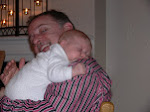
6:34 a.m. -- 7 months, 1 day
When M was pregnant, we pondered what would happen if our child developed our worst traits. Combining M's tendency toward rigidity with my inclination to delay, we decided, would create one worst-case scenario: a militant procrastinator.
"A militant procrastinator?" said our brother-in-law J, who directs a social justice agency. "That's me!" We could do a lot worse than create another J, so we moved on to other concerns.
Baby A wasn't long in the world when we realized she'd developed another trait that each of her parents unproudly possesses: impatience, especially with herself. Most observers agree the kid is a quick study, but you can't tell her that. The moment she realizes there's a skill she wants but hasn't mastered, then Katie bar the door, for the tantrums will surely follow.
Exhibit A: Baby A wants to move, but she's not sure how the crawling thing works. These days, nothing turns her infant joy to rage faster than the frustration of limited motility.
Perhaps it's her parents' fault. Another possibly difficult inheritence for the child will be her father's clumsy fine-motor coordination, which renders almost impossible such tasks as buttoning tiny buttons or inserting tiny tabs of toddler arms into skinny slots of toddler sleeves. Wanting to spare both me and Baby A painful moments of garment wrestling, M has from Day 1 provided a wardrobe consisting almost entirely of onesies, which among their advantages are easy to snap and remove.
But keeping the kid in footie pajamas 24 hours a day prevents her from gripping the world's surfaces with her toes, which makes crawling slippery.
Then there's our desire to keep the kid well herded, which means she spends long minutes either in her secure playpen or in the one area of the house not covered with hardwood floors: the carpeted sunroom we call, by virtue of its most prominent feature, the Buddha room. For adults, it features lots of low furniture like floor cushions. (We don't spend much time with the grandparents out there.) This means that Baby A's prime crawling space often features her father sprawled on the floor nearby, his head propped on a cushion.
As a result, Baby A has become exceptionally good at climbing and standing. She'll be on her hands and knees, ready to move. Then she'll see me, and rather than keep her limbs on the ground she uses her strong legs to frog-hop onto my body, where she practices rock-climbing moves on my limbs, torso, and face.
She wants to be vertical, glorying in her ability to push or pull herself up, hands placed flat on my torso or some other low surface, pleased no matter how tottery, oblivious to hovering parental hands ready to arrest her tumbles. The other day she pulled herself upright from a sitting position using only the edge of a low glass table (which we've covered with thick, taped towels but which remains dangerous enough to alarm her father): her best stand yet.
But crawling? Not so much. Perhaps it's because she has no role models. I try to demonstrate, but I can't even tell if crawling involves moving one's hands and knees in opposition, as in walking, or together (left-left, right-right). It sort of works either way, and my crawling instincts are shot. And I keep forgetting to watch when I meet other toddlers. Maybe there's an instructional video on the Net. In any case, Baby A watches my lumbering around the carpet with engagement but no obvious benefit.
Of all the toys in the Buddha room, the stuffed monkeys and bandy-legged giraffes and vibrating elephants and candy-colored rattles, Baby A's favorites are the plastic rings used to attach them to the playpen frame. So yesterday, while sitting and conducting a favorite experiment -- testing a ring's air resistance by using her right arm to shake it vigorously through the atmosphere -- she mistakenly hurled the ring out of reach.
Wanting the experiment to continue, she turned toward the ring, dropped to her hands and knees, and without a second's hesitiation crawled forward two-and-a-half paces before grabbing it, sitting, and restarting the shake test. I startled her by cheering and applauding, my joy checked only by my annoyance that I hadn't noticed if she'd moved her limbs oppositionally. Delighted that I enjoyed her ring-resistance research as much as she, she redoubled her efforts.
A few minutes later, her attention was engaged by a distant cloth rattle shaped like a pig's face. (Don't ask.) This time, after dropping to her hands and knees, she made the fatal mistake of thinking. She considered her next step, butt rocking back and forth. How the hell does this work? It makes no intuitive sense whatsoever. Why can't the toys just bring themselves to me?
Finally she lowered her head, pushed off on her arms, kicked her legs, moved two paces backward, looked up, noticed her regression, dropped her hips and head to the ground, and began to wail.
Her rage could have concerned the absence of the distant toy. But, speaking as one well practiced in self recrimination, I thought I knew better. Not that my knowledge proved any consolation to either of us.
I've got to go find a crawling how-to video.

1 comment:
Wow. I LOVE the description of Baby A's second attempt to move -- complicated by her thinking. Boy, does THAT ever say a lot about the relationship between body and mind.
Again -- when are you going to submit this somewhere???
Your stage mother,
Heidi
Post a Comment